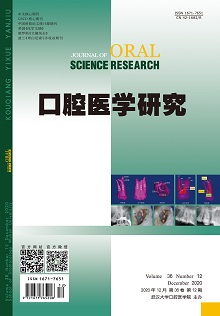|
|
Effects of Luteolin on NLRP3/IL-1β Signal Pathway and Bone Remodeling in Periodontitis Rats.
LI Yuanhui, XING Kongcai, WANG Yiting , LI Xiaohong
2020, 36(12):
1117-1122.
DOI: 10.13701/j.cnki.kqyxyj.2020.12.009
Objective: To investigate the effects of luteolin on the signal pathway of nucleotide-binding oligomerization domain-like receptor protein 3 (NLRP3)/interleukin-1β (IL-1β) and bone remodeling in periodontitis rats. Methods: SD male rats were randomly divided into four groups: control group (gavage with the same amount of saline), model group (gavage with the same amount of saline), luteolin low and high dose groups (given 50 mg/kg and 100 mg/kg luteolin by gavage), once a day, with 10 in each group. Except the control group, the other groups of rats were prepared with periodontitis model. After 7 days of continuous administration, the trabecular number (TB.N), trabecular separation (Tb.Sp), trabecular thickness (Tb.Th), and alveolar bone absorption were observed by Micro-CT. HE staining was used to observe the pathological changes of periodontal tissues. The number of osteoclasts in periodontal tissue was observed by tartrate resistant acid phosphatase (TRAP) staining. The expressions of nuclear factor κB receptor activator ligand (RANKL) and osteoprotegerin (OPG) were determined by immunohistochemistry. Western blot was used to detect the protein expressions of NLRP3 and IL-1β in periodontal tissues. Results: Compared with those in the control group, the periodontal fibers in the model group were disorganized, the periodontal membrane was narrow, the surface of alveolar bone was not smooth, and there were more bone resorption lacunae. TB.N and Tb.Th in alveolar bone and the expression of OPG in periodontal tissue were significantly lower (P<0.05), while Tb.Sp, CEJ-ABC value, osteoclast number, RANKL expression, NLRP3, and IL-1β protein expressions in periodontal tissue were significantly higher (P<0.05). Compared with those in the model group, the periodontal fibers in the low and high dose luteolin groups were arranged in order, and the above pathological symptoms were alleviated obviously, TB.N and Tb.Th in alveolar bone and the expression of OPG in periodontal tissue increased in turn (P<0.05), while Tb.Sp, CEJ-ABC value, osteoclast number, RANKL expression, NLRP3, and IL-1β protein expressions in periodontal tissue decreased in turn (P<0.05). Conclusion: Luteolin may reduce the periodontal tissue damage and promote the alveolar bone remodeling by inhibiting NLRP3/IL-1β signal pathway.
References |
Related Articles |
Metrics
|

